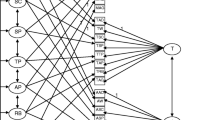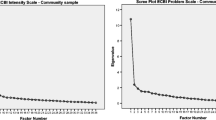Abstract
Using equivalent scales, the differential utility of teachers' ratings of elementary school (n=142) and inpatient (n=83) 8 to 12yearold children was examined by comparing teachers' correspondence with the inpatient and elementary school children's selfreports of depression, anxiety, and aggression. Teacherchild correspondence was significant for all three traits in the elementary school sample, yet only significant for aggression in the inpatient sample. However, the level or severity of depression and anxiety symptoms that the teachers reported for the inpatient sample was similar to that reported by the children themselves. In contrast, elementary school children reported significantly more internalizing symptoms than their teachers. Inpatient children reported more depression, but not significantly more anxiety and aggression than elementary school children. For all traits, teachers reported significantly more symptoms for inpatient children, after controlling for child selfreport and socioeconomic status. The utility of teachers' ratings across samples, method variance and rater biases, and issues pertaining to selfreport are discussed.
Similar content being viewed by others
References
Achenbach, T. M., & Edelbrock, C. (1991).Manual for the Youth Self-Report and 1991 Profile. Burlington: University of Vermont, Department of Psychiatry.
Achenbach, T. M., McConaughy, S. H., & Howell, C. T. (1987). Child/adolescent behavioral and emotional problems: Implications of cross-informant correlations for situational specificity.Psychological Bulletin, 101, 213–232.
Brady, E. U., & Kendall, P. C. (1992). Comorbidity of anxiety and depression in children and adolescents.Psychological Bulletin, 111, 244–255.
Epanchin, B. C., & Rennells, M. S. (1989). Parents' and teachers' sensitivity to unhappiness reported by undercontrolled children.Behavioral Disorders 14, 166–174.
Epkins, C. C. (1989).Childhood depression: The multitrait-multimethod approach revisited. Unpublished master's thesis, Memphis State University, Memphis, TN
Epkins, C. C. (1993).Peer ratings of depression, anxiety, and aggression in inpatient and elementary school children: Influence of rater's depression, anxiety, and aggression. Manuscript submitted for publication.
Epkins, C. C., & Keisling, B. L. (1993).Teachers' ratings of inpatient children's depression,anxiety, and aggression: A preliminary comparison between inpatient-facility and community-based teachers and their correspondence with children's self-report. Manuscript submitted for publication.
Epkins, C. C., & Meyers, A. W. (in press). Assessment of childhood depression, anxiety, and aggression: Convergent and discriminant validity of self-, parent-, teacher-, and peer-report measures.Journal of Personality Assessment.
Epkins, C. C., Whelan, J. P., & Meyers, A. W. (1993).Childhood depression, anxiety, and aggression: A confirmatory factor analysis of a multitrait-multimethod investigation across childhood populations. Manuscript submitted for publication.
Hollingshead, A. B. (1975).Four factor index of social status. Unpublished manuscript, Yale University, Department of Sociology.
Ines, T. M., & Sacco, W. P. (1992). Factors related to correspondence between teacher ratings of elementary student depression and student self-ratings.Journal of Consulting and Clinical Psychology, 60, 140–142.
Jensen, P. S., Xenakis, S. N., Davis, H., & Degroot, J. (1988). Child psychopathology rating scales and interrater agreement: II. Child and family characteristics.Journal of the American Academy of Child and Adolescent Psychiatry, 27, 451–461.
Kavanagh, M. J., MacKinney, A. C., & Wolins, L. (1971). Issues in managerial performance: Multitrait-multimethod analyses of ratings.Psychological Bulletin, 75, 34–49.
Kazdin, A. E., Esveldt-Dawson, K., Unis, A., & Rancurello, M. (1983). Child and parent evaluations of depression and aggression in psychiatric inpatient children.Journal of Abnormal Child Psychology, 11, 401–413.
Kovacs, M. (1983).The Children's Depression Inventory: A self-report depression scale for school-aged youngsters. Unpublished manuscript, University of Pittsburgh School of Medicine.
Mokros, H. B., Poznanski, E., Grossman, J. A., & Freeman, L. N. (1987). A comparison of child and parent ratings of depression for normal and clinically referred children.Journal of Child Psychology and Psychiatry, 28, 613–627.
Nieminen, G. S., & Matson, J. L. (1989). Depressive problems in conduct-disordered adolescents.Journal of School Psychology, 27, 175–188.
Pekarik, E. G., Prinz, R. J., Liebert, D. E., Weintraub, S., & Neale, J. M. (1976). The Pupil Evaluation Inventory: A sociometric technique for assessing children's social behavior.Journal of Abnormal Child Psychology, 4, 83–97.
Pelham, W. E., Jr., Gnagy, E. M., Greenslade, K. E., & Milich, R. (1992). Teacher ratings of DSM-III-R symptoms for the disruptive behavior disorders.Journal of the American Academy of Child and Adolescent Psychiatry, 31, 210–218.
Phares, V., Compas, B. E., & Howell, D. C. (1989). Perspectives on child behavior problems: Comparisons of children's self-reports with parent and teacher reports.Psychological Assessment, 1, 68–71.
Pliszka, S. R. (1992). Comorbidity of attention-deficit hyperactivity disorder and overanxious disorder.Journal of the American Academy of Child and Adolescent Psychiatry, 31, 197–203.
Rey, J. M., Schrader, E., & Morris-Yates, A. (1992). Parent-child agreement on children's behaviours reported by the child behaviour checklist (CBCL).Journal of Adolescence, 15, 219–230.
Reynolds, C. R., & Richmond, B. O. (1978). What I Think and Feel: A revised measure of children's manifest anxiety.Journal of Abnormal Child Psychology, 4, 271–280.
Richters, J. E. (1992). Depressed mothers as informants about their children: A critical review of the evidence for distortion.Psychological Bulletin, 112, 485–499.
Romano, B. A., & Nelson, R. O. (1988). Discriminant and concurrent validity of measures of children's depression.Journal of Clinical Child Psychology, 17, 255–259.
Sacco, W. P., & Graves, D. J. (1985). Correspondence between teacher ratings of childhood depression and child self-ratings.Journal of Clinical Child Psychology, 14, 353–355.
Sawyer, M. G., Baghurst, P., & Mathias, J. (1992). Differences between informants' reports describing emotional and behavioural problems in community and clinic-referred children: A research note.Journal of Child Psychology and Psychiatry, 33, 441–449.
Shoemaker, O. S., Erickson, M. T., & Finch, A. J., Jr. (1986). Depression and anger in thirdand fourth-grade boys: A multimethod assessment approach.Journal of Clinical Child Psychology, 15, 290–296.
Stavrakaki, C., Vargo, B., Roberts, N., & Boodoosingh, L. (1987). Concordance among sources of information for ratings of anxiety and depression in children.Journal of the American Academy of Child and Adolescent Psychiatry, 26, 733–737.
Treiber, F. A., & Mabe, P. A. (1987). Child and parent perceptions of children's psychopathology in psychiatric outpatient children.Journal of Abnormal Child Psychology, 15, 115–124.
Verhulst, F. C., & van der Ende, J. (1991). Assessment of child psychopathology: Relationships between different methods, different informants and clinical judgment of severity.Acta Psychiatrica Scandinavica, 84, 155–59.
Verhulst, F. C., & van der Ende, J. (1992). Agreement between parents' reports and adolescents' self-reports of problem behavior.Journal of Child Psychology and Psychiatry, 33, 1011–1023.
Wolfe, V. V., Finch, A. J., Jr., Saylor, C. F., Blount, R. L., Pallmeyer, T. P., & Carek, D. J. (1987). Negative affectivity in children: A multitrait-multimethod investigation.Journal of Consulting and Clinical Psychology, 55, 245–250.
Zoccolillo, M. (1992). Co-occurrence of conduct disorder and its adult outcomes with depressive and anxiety disorders: A review.Journal of the American Academy of Child and Adolescent Psychiatry, 31, 547–556.
Author information
Authors and Affiliations
Rights and permissions
About this article
Cite this article
Epkins, C.C. A preliminary comparison of teacher ratings and child self-report of depression, anxiety, and aggression in inpatient and elementary school samples. J Abnorm Child Psychol 21, 649–661 (1993). https://doi.org/10.1007/BF00916448
Revised:
Issue Date:
DOI: https://doi.org/10.1007/BF00916448




